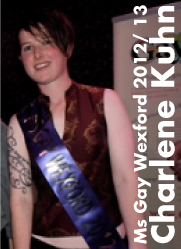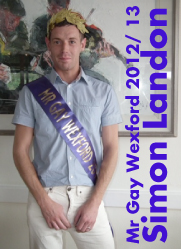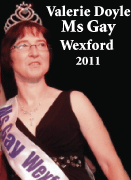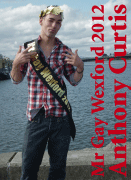.
Let’s talk
-
Recent Posts
- Wexford vigil for Sligo murder victims Aidan Moffitt & Michael Snee.
- Cover • Aidan Moffitt & Michael Snee
- Irish Prides 2019
- Irish Pride 2018
- Waterford Winter Pride Nov 23-26
- Irish Prides 2017
- Summer Solstice 2017• Personal Development • Health & Wellbeing • Day of Yoga
- Waterford Pride 2016 • November 17 – 20
May 2024 M T W T F S S 1 2 3 4 5 6 7 8 9 10 11 12 13 14 15 16 17 18 19 20 21 22 23 24 25 26 27 28 29 30 31 Follow Us
- No public Twitter messages.
-
Category Archives: History
Gay Pride & the 1st Rainbow Flag & designer, Gilbert Baker • Harvey Milk
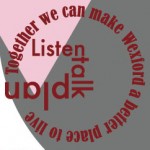
Color has long played an important role in our community’s expression of pride. In Victorian England, for example, the color green was associated with homosexuality. The color purple (or, more accurately, lavender) became popularized as a symbol for pride in the late 1960s – a frequent post-Stonewall catchword for the gay community was “Purple Power”, of course, there’s the pink triangle. Although it was first used in Nazi Germany to identify gay males in concentration camps, the pink triangle only received widespread use as a gay pop icon in the early 1980s. But the most colorful of our symbols is the Rainbow Flag, and its rainbow of colors – red, orange, yellow, green, blue, and purple – represents the diversity of our community.
The first Rainbow Flag was designed in 1978 by Gilbert Baker, a San Francisco artist, who created the flag in response to a local activist’s call for the need of a community symbol. (This was before the pink triangle was popularly used as a symbol of pride.) Using the five-striped “Flag of the Race” as his inspiration, Baker designed a flag with eight stripes: pink, red, orange, yellow, green, blue, indigo, and violet. According to Baker, those colors represented, respectively: sexuality, life, healing, sun, nature, art, harmony, and spirit. Baker dyed and sewed the material for the first flag himself.
Baker soon approached San Francisco’s Paramount Flag Company about mass producing and selling his “gay flag”. Unfortunately, Baker had hand-dyed all the colors, and since the color “hot pink” was not commercially available, mass production of his eight-striped version became impossible. The flag was thus reduced to seven stripes.
In November 1978, San Francisco’s gay community was stunned when the city’s first openly gay supervisor, Harvey Milk, was assassinated, Wishing to demonstrate the gay community’s strength and solidarity in the aftermath of this tragedy, the 1979 Pride Parade Committee decided to use Baker’s flag. The committee eliminated the indigo stripe so they could divide the colors evenly along the parade route – three colors on one side of the street and three on the other. Soon the six colors were incorporated into a six-striped version that became popularized and that, today, is recognized by the International Congress of Flag Makers**.
The flag consisted of eight stripes; Baker assigned specific meaning to each of the colours:
hot pink: sexuality |
red: life |
| orange: healing |
| yellow: sunlight |
| green: nature |
| turquoise: magic/art |
| indigo/blue: serenity/harmony |
| violet: spirit |
“I love going to cities around the world and seeing the rainbow flag, knowing that it’s a safe place where I can be myself,” says Gilbert Baker the man who created the flag 30 years ago.
“In 1978, when I thought of creating a flag for the gay movement there was no other international symbol for us than the pink triangle, which the Nazis used to identify homosexuals in concentration camps. Even though the pink triangle was and still is a powerful symbol, it was very much forced upon us,” says Baker.
“I almost instantly thought of using the rainbow. To me, it was the only thing that could really express our diversity, beauty and our joy. I was astounded nobody had thought of making a rainbow flag before because it seemed like such an obvious symbol for us.”
Born and raised in Kansas, Baker was drafted into the US army at 19 and served as a nurse in Vietnam for two years. While in the army Baker fell in love with a fellow soldier, an experience he describes as the most transformative moment of his life. “When I fell in love, all the shame and guilt I carried with me for years suddenly vanished.”
After his tour in Vietnam, Baker moved to San Francisco, a vibrant and socially progressive city that was full of culture, and where individuality was celebrated rather than repressed – very much the opposite to his native Kansas.
Gender-bending glam rockers, hippies and beatniks were flocking to San Francisco at this time and for Gilbert it was the passion for fashion and a lack of cash that sparked his interest in sewing. To his own amusement he quickly became known as the “seam master” on the gay scene:
“I would be the guy they’d call up when they needed banners for demonstrations. That became my role in the gay movement and I am very proud to say that my craft was my activism, it still is.”
“The rainbow flag has become far more than just a flag, it gives people hope. When LGBT people across the world fly this flag they are saying something, they are taking action.”
Excerpts taken from an interview by Kristina Baker for the independant, Thursday, 19 June 2008
** a confusion of the titles of two flag organisations • International Association of Vexillological Associations, and the Flag Congress.
Posted in Coming Out, History, prides
Tagged and violet, art, blue, community's expression of pride, Gay Pride, Gay Pride Flag, Gilbert Baker, green, harmony, healing, indigo, life, nature, orange, pink, Rainbow Flag, red, Sexuality, spirit, sun, yellow
Comments Off on Gay Pride & the 1st Rainbow Flag & designer, Gilbert Baker • Harvey Milk
April cover
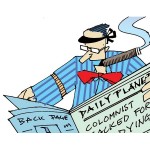
Roger Casement: The Gay Irish Humanitarian Who Was Hanged On a Comma article
David Norris confirmed his re-entry into the presidential race • 16 September 2011

Excerpt below from en.wikipedia.org
Re-entry
Despite withdrawing from the presidential race in July 2011, Norris maintained considerable and, in some cases, increased public support. A poll taken one week after Norris withdrew from the ** presidential race, showed a large increase in public support for his Presidency if they were given the choice to vote for him (topping the poll by a considerable margin) with 40 per cent of respondents now saying they would vote Norris number one in the proportional representation electorial system and 50 per cent saying they would give him a vote.
Goto> Senator David Norris Website
Goto> Norris for President Website
David Norris’s presidential nomination shows Ireland has come a long way • From gay activist to frontrunner for president, David Norris’s story says much about Ireland’s progress over the past 30 years – by Colm Tóibín guardian.co.uk, Tuesday 27 September 2011 21.28 BST Ireland-David-Norris-Long Way
In Galway city alone, more than 1,000 signatures in support of Norris for President were gathered from members of the public in just 12 hours on the weekend of 11 September. There was a similar result in the city of Cork. Days later, Norris was presented with a petition of 10,000 signatures, collected nationwide, by the We Want Norris campaign outside Leinster House. As a result Norris announced his return to the campaign on the Irish television talk programme The Late Late Show on Friday 16 September 2011, though he did not reveal the precise number of signatures belonging to TDs and Senators that he had secured. A Sunday Independent/Millward Brown Lansdowne opinion poll published on 18 September showed a high amount of popular support for Senator David Norris of 34 per cent.
“I’m not perfect and I’m not pretending to be perfect. If you’re waiting for a perfect president, you’ll be waiting a long time … I abhor abuse of children … This would be the biggest comeback in Irish political history. I think people love a comeback.”
David Norris confirmed his re-entry into the presidential race on a late-night appearance onThe Late Late Show with Ryan Tubridy on 16 September 2011.
Despite attempts, Norris didn’t receive sufficient support from Oireachtas members to gain a nomination, having been nominated by 18 members, two short of the minimum number of 20. However, he received a nomination from four county councils (Fingal, Laois, Waterford and Dublin City), which is sufficient to gain a nomination. He was assisted by his rival, Labour Party candidate Michael D. Higgins, who urged his party colleagues on Dublin City Council to allow Norris onto the ticket “in the interests of democracy.” When Norris heard this on the radio he instructed his driver to stop the car so that he could phone Higgins to express his appreciation.
According to The Irish Times Norris had four times as many followers on Twitter as any of the other candidates as of 30 September.
In the first debate, held on RTÉ Radio 1’s News at One, Norris promised the electorate he would have no difficulty in either visiting Israel or in meeting Pope Benedict XVI as President of Ireland. Speaking after the disclosure of various fees received by his rivals Mary Davis and Seán Gallagher after they were appointed to State and commercial boards, Norris confirmed he had no stocks or shares to his name and that he was not a company director. Norris launched his campaign at Dublin Writers Museum on 5 October 2011.
He came fifth (of seven candidates) in the election receiving 109,469 (6.2%) first preference votes.
** The Irish presidential election of 2011 was the thirteenth presidential election to be held in Ireland, and the first to be contested by a record seven candidates. It was held on Thursday, 27 October 2011. The election was held to elect a successor to Mary McAleese, with the winner scheduled to be inaugurated as the ninth President of Ireland on 11 November 2011.
Posted in History
Tagged 16 September 2011, Candidate, David Norris, Dublin Writers Museum, Friday, Labour Party, Mary Davis, Michael D. Higgins, Norris for President, Seán Gallagher, The Late Late Show
Comments Off on David Norris confirmed his re-entry into the presidential race • 16 September 2011
David Norris steps away from Presidential campaign • August 2nd 2011

The tweets were scrolling down tweetdeck, fast & furiously. Variations on the theme, Senator Norris steps down from Presidential Campaign. The reaction on the internet has been interesting. Particularly gay media. David Norris had been favorite to succeed after President … Continue reading

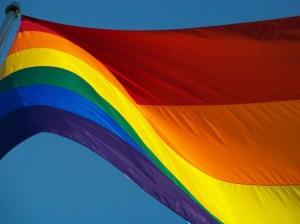
 Follow
Follow